July 11, 2018
| Valerie Hayes
| Business & Web Development, Designer History, Inside Passage Legendary Map, My Story, Poetry By Valerie Hayes, Thoughts & Ideas, View All Articles & Photos
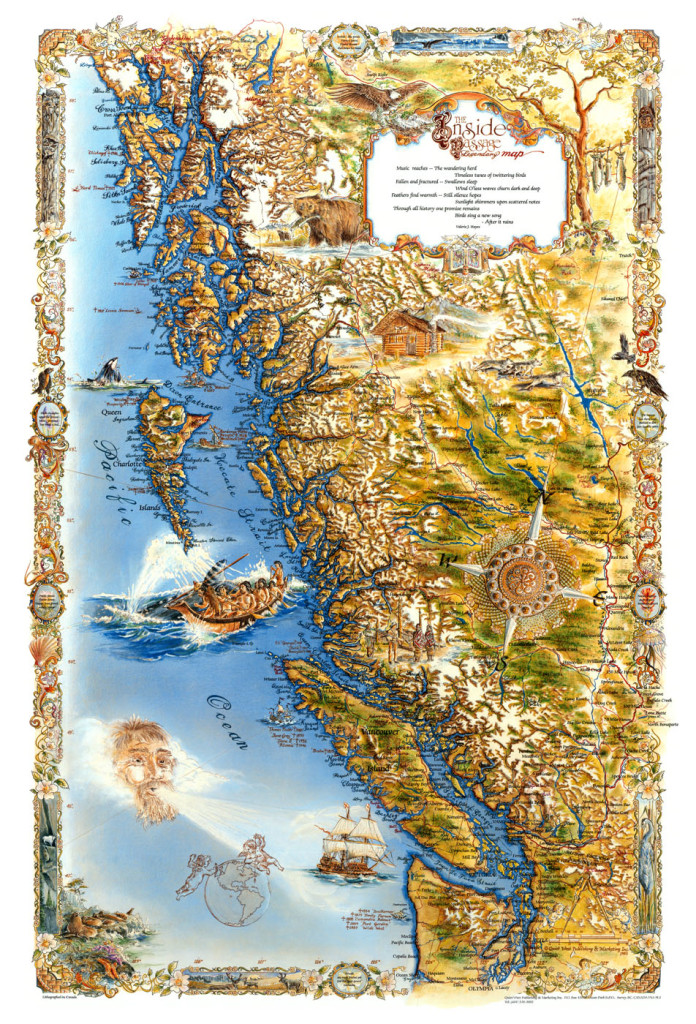
The Inside Passage Map is a soulful and romantic map integrating cartography, poetry, visual art, historical research, inspiration, nature and different cultures of people.
A unique portrayal of the west coast has been created. The goal was to create a beautiful collector’s map with a diverse range of information and ideas.
At the heart of the map is the desire to bring recognition and appreciation for the power and harmony within lyric poetry – by bringing it to you alive – as art.
Points of Interest
The Border – Intricate and full of detail, the design alternates between panoramic west coast scenery and flowers, with sea life weaved in between. The decorative cameos, which are centered in the border, contain ghosted flowers and verse. This tiny poem is referred to as the “rhyming riddle”. If you follow the rhyme of each line within each cameo, you will be able to figure out the correct order of the verse. It was originally written as a twelve-line poem. It captures the overall theme and design of the map.
The Legend Box – The legend box gives the title and the main poem, which together, create a parallel between both the outer and inner conditions that we face in our lives. The third line of the poem refers to tragedy and death (swallows sleep). Wind O’less means windowless and refers to the inner person. Inside of ourselves – unseen by other people, the waves of emotion, the cycles of despair, and contractions of grief are compared to the waves of the ocean in force and rhythm. The Inside Passage poem was born of this understanding. It is a sequel to grief-written poems called Lunar Tunes and Window Pain.
The Quiet-West Crest – The bottom center of the legend box is a crest designed to visually express the profile and goals of Quiet West Publishing. Firstly it contains a scrolled map to represent the historical BC coastal collector’s map concept. An open book contains reductions of actual stained glass windows with images of ladies wearing brimmed hats. Above the book a paintbrush and pen are crossed, combining the literary and visual arts. The rising sun represents the hope we have for each tomorrow.
Cartouches – The eagle, sighted frequently along the west coast is shown flying down to her nest and represents responsibilities to future generations. The bear, shown to the left of the legend box, is near Tatshenshini – Alsek Park. This region, which is home to countless species of wildlife, is one of the most important protected wilderness parks in the world. To the left of the compass rose, there is a scene depicting trade between the European and Haida people. The costumes, along with the illustration of the Haida settlement in the background are historically and culturally representative. The Nuu-chal-nuth people are featured in the whaling expedition scene. This dramatic cartouche was placed in close proximity to Quatsino Sound, the historical whaling harbor on northern Vancouver Island. The face in the wind represents the stormy and treacherous conditions on western Vancouver Island and the Olympic Peninsula. Cherubs hover over the globe to show the location of the Inside Passage and to represent a stylistic feature commonly used on seventeenth century maps.
The Compass Rose – The interesting and elaborate compass rose design was created by placing a borrowed seventeenth century brooch on a hand-made European lace doily. The brooch was brought to Canada by Scandinavian war bride Elinor Thun. She wrote the description as follows: “This particular brooch is more than eight hundred years old, and came from a western fjord in Norway at Siem, near Bergen from the maternal side of my family. It is known in Norwegian as “solje or kappe-brosje”. Brooches of these types were used by men and women to hold their capes in place. Jewelry of the day was worn as an expression of wealth, and would sometimes be given as gifts from one king to another. The Vikings were great travellers and the designs show an eastern flair which would eventually weave itself into the culture of the Norse-lands.” Elinor Thun Ueland 1994.
Cartography – The map was created by using an extensive amount of historical reference material, by translating poems into images – and by merging art with technology. Land contours and shoreline details were carefully blended to create emphasis and depth. Mossy greens, white mountain peaks, rich earth tones, hand lettered names, and locations of notable shipwrecks bring harmony and intrigue into the map.
Whether your interests are philosophical or artistic, this map demonstrates originality and lasting value. It is a truly great work – to honour one of the most beautiful places in the world.
Measures 24″ x 36″.
Created and Published in 1993 by Quiet West Publishing & Marketing.
Purchase on this website for $40.00 each + Shipping. It can be found under Categories – Accessories Art Objects. Two for $35.00 each. For wholesale prices contact Valerie at quietwest@yahoo.com.
https://www.quietwest.com/shop/accessories/inside-passage-legendary-map-24-x-36-detailed-west-coast-collectors-map/
Copyright Valerie J. Hayes and Quiet West Vintage (2018). Unauthorised use and/or duplication of this material without express and written permission from this blog’s author/owner is strictly prohibited. Excerpts and links may be used, provided that full and clear credit is given to Valerie J. Hayes and Quiet West Vintage with appropriate and specific direction to the original content.
July 7, 2018
| Valerie Hayes
| Health & Wellness, Inside Passage Legendary Map, My Story, Thoughts & Ideas, View All Articles & Photos
Although I worked as a Registered Nurse for many years, I was always trying to get out of it because it was not my forte in the first place. I was just sixteen when I graduated from high school. There were aspects of working as an RN that I did enjoy. But it was the old-fashioned hierarchy, the baggage associated with how I got into it, the system itself, and the career limitations I found to be demotivating, stifling and restrictive. I felt trapped in a cage.
The direct patient care and advocacy was the most rewarding part. Up until the early nineties, it was not a well-paid profession. The only reason for the decades of low pay, is the fact it is a female dominated profession. The work itself can be taxing – mentally, physically and emotionally. The stressors are compounded for single mothers who work as nurses because of the long hours, shift work, fatigue, and difficulty with child care.
For about ten years I worked in a very busy labor and delivery unit. In addition to caring for women throughout their labor and delivery, we had to clean the rooms after each delivery, rinse all the linen, soak, wash, and autoclave all the instruments and repack the delivery bundles. The janitors would not wash the floors unless they had been cleaned by the nurses first. We had to move furniture all over the ward non-stop, in order to make room for the next patients. It was a constant game of musical beds – without the music. They have made improvements to the labor and delivery units over time, but aspects of it were still quite archaic back then.
We could not ignore the task of charting every fifteen minute heart rate and blood pressure checks, as well as getting a mound of paperwork done after each delivery. The legal documentation was the only thing that mattered if anything went awry. You could not afford to get your priorities mixed up when it was busy, or it could be catastrophic. For example – people have a tendency to bleed (especially red heads – believe it or not), and sometimes they bleed profusely. In maternity – they can bleed out in a matter of minutes.
There is no room for error when it comes to the need for early detection of fetal distress and postpartum bleeds (and premature labour). Due to the unpredictable and often precipitate nature of labour and delivery, I estimate having delivered around two hundred babies over the years. In some cases, unknown to the general public – the delivery room can be as hair raising as anything you can imagine. It is difficult to overcome the fear of having to handle, let alone resuscitate – a two pound baby.
Following the years in labor and delivery, I did stints in community mental health, long term care (to include psycho-geriatrics), emergency, some medical-surgical, and often as a hospital-wide float. From newborn to ninety – there are some poignant realizations stemming from the nursing experiences. Being witness to so many people coming into this world, as well as caring for those who are leaving it, has a lasting impact. The astounding thing to me – is how unique each individual is, in every conceivable way.
Not one of us has exactly the same experiences – from how we come into this world, to how we make our final exit. Getting hung up at the “spines” as they call it in the labor room – is when the baby’s head cannot get past the small bony prominences in the pelvis. Something as simple as the presentation of the head can lead to a cord around the neck, a cord prolapse, a failure to progress in labor, an emergency cesarean section, and in some cases, injury to the brain.
We have no guarantees in life – from conception, until the time is ripe for the forces of nature to plunge us into that first uncharted trip through the bony pelvis. That’s just to get us here, for our personalized and idiosyncratic journey. Along the way choices can be limited, or completely taken away from us. In reality – it’s all somewhat of a crap shoot.
Who can say what kinds of things will happen to any of us? But throughout slogging out the twelve hour night shifts and trying to think of a different way to make a living, I tried giving birth to many ideas as well. From the time I was a student nurse, I shopped in thrift stores, and found it way more interesting than any other kind of shopping. I soon became hooked on collecting vintage clothing.
To justify the addiction – I started to view vintage and designer items as being like penny stock investments. There was a reasonable expectation in my mind that if taken care of, they would increase in value over time. The idea of having tangible products appealed to the poet in me, as I do sometimes have my head in the clouds. Thoughts and ideas (and stock market investments) can go up in vapour, whereas palpable things stay put.
The oldest, and some of the most exquisite dresses in the collection are still in storage. Since I started collecting, I wanted to prove that the material landscape of the dispossessed (or throwaways) is of greater interest and value than new things that are mass produced and bought at the mall. Vintage hats and antique lace really inspired me for some reason.
The same thing applies to the internal landscape of the dispossessed. If adversity does not destroy or make us bitter – it will gift us with autonomy, courage, and artistic expressions to share with the outside world. We may need to go to battle with our past – in order to salvage our own souls, as we traverse our peerless internal landscape. Entelechy is the survival of potential.
For a few years I left nursing and worked with a PhD research scientist who had an incredible academic record, twenty-two years of post-secondary education. His PhD was in linguistics with other degrees in math and computer science. We published maps and did special applications contracts using advanced remote sensing technology. We also published a Cities From Space Series using the Landsat satellite data. We sold a couple hundred thousand satellite image maps during that time frame. This was in the late eighties, before satellite imagery was available to the public on the Internet. Advanced remote sensing technology was still in its infancy, but for a micro-enterprise of just two people, we did publish and expand on different uses for the remote sensing technology and digital image processing.
After a couple years of publishing satellite imagery, getting more creative with the mapping elements really started to appeal to me. I started buying old atlases and maps from thrift stores to study the early artistic collector’s maps. I went to trade shows with the maps and saw all of the other creative arts projects that were on display at the shows. Along with the maps and Cities From Space series we published place mats, fridge magnets, and huge wall murals for fire control rooms, real estate, Geological Survey Canada, and many others.
What I learned is that good product is very time-consuming to make. Once it is made – it still has to be marketed. I started my own company, Quiet West Publishing & Marketing and began working on a mosaic and map to cover the entire BC coastline with multiple artistic elements. This was a visionary overlay, with the additional dimensions of true ground and shoreline features. The creation of the Inside Passage Legendary Map came from the exposure I had to satellite image mapping technology – combined with the poetry and art. I saw this as being the ultimate blend of ideas.
BC has thousands of micro-entrepreneurs and artists. They are highly concentrated on the Islands, in and around Nelson, among the Aboriginal people, and basically all over BC. The gift show typically featured a BC Creative Arts section. Hand made jewelry, pottery, artwork, and wood items are the most predominant. But the sky is the limit – and the birdhouses are so cute!
For the most part – the creative arts is about doing a labor of love. There are certain parallels and analogies surrounding the birth of an idea – and how they can take on a life of their own. Labor is central to our lives in more ways than one.
The basis of an entrepreneur’s optimism and repeated efforts – in spite of the odds and the risk she faces, is aptly reflected in a quote credited to Napoleon Hill: “More gold has been mined from the thoughts of men than has been taken from the earth.”
And to that quote – we can take the liberty to add women, right there beside the men. Why? Because the poverty faced by women, also affects the children women give birth to.
In addition, being robbed of our potential is worse than a protracted labor pain. It is one long and extended contraction, until the adversity gives birth to change. We do not deserve the pain and struggle of poverty and hard work without reward, or sufficient support systems. The children who happen to be born into that cycle do not deserve to be dehumanized either. It only creates confusion and withdrawal surrounding thinkable outcomes.
It is time to start mapping it out – and change the archetype.
Copyright Valerie J. Hayes and Quiet West Vintage (2018). Unauthorised use and/or duplication of this material without express and written permission from this blog’s author/owner is strictly prohibited. Excerpts and links may be used, provided that full and clear credit is given to Valerie J. Hayes and Quiet West Vintage with appropriate and specific direction to the original content.
August 22, 2017
| Valerie Hayes
| Inside Passage Legendary Map, My Story, Poetry By Valerie Hayes, Thoughts & Ideas, View All Articles & Photos
Music reaches the wandering herd,
Timeless tunes of twittering birds ~
Fallen and fractured – Swallows sleep
Wind O’less waves churn dark and deep.
Feathers find warmth – Still silence hopes
Sunlight shimmers upon scattered notes ~
Through all history one promise remains —
Birds sing a new song ~
After it rains.
Valerie Hayes
Sky So Blue
Like me – The sky is so blue ~
Then the setting sun – With a purplish hue;
Bruises & bleeds – Clear across the skies ~
‘Til absorbed by the darkness – & Shadows our lives…
Valerie Hayes
1992
Copyright Valerie J. Hayes and Quiet West Vintage (2017). Unauthorised use and/or duplication of this material without express and written permission from this blog’s author/owner is strictly prohibited. Excerpts and links may be used, provided that full and clear credit is given to Valerie J. Hayes and Quiet West Vintage with appropriate and specific direction to the original content.
March 17, 2015
| Valerie Hayes
| Inside Passage Legendary Map, Poetry By Valerie Hayes, Thoughts & Ideas, Valerie Hayes, View All Articles & Photos
This Inside Passage Legendary Map poem was written as a “rhyming riddle” to enhance the lyric voice on the map. It is placed in two line segments in the cameos around the border of the Inside Passage Legendary Map. One of the extra detailed features of the map – is to be able to figure out the order of the verse in the border of the map.
Poet-Pourri
Words like petals – Form a poem;
Flower blooms – Then bows her head.
Sheds thoughts upon the ground ~
Moss – Prepared – Has made a bed
Poetic petals flutter down.
Depart from proud, stately stems
‘Til Nature has them land
Bathed in dew – Just humble gems.
Nature inspires deep respect,
Sweet pot-pourri recants…
Woods are made fresher yet ~
For the poet-pourri – Enchants.
Valerie J. Hayes
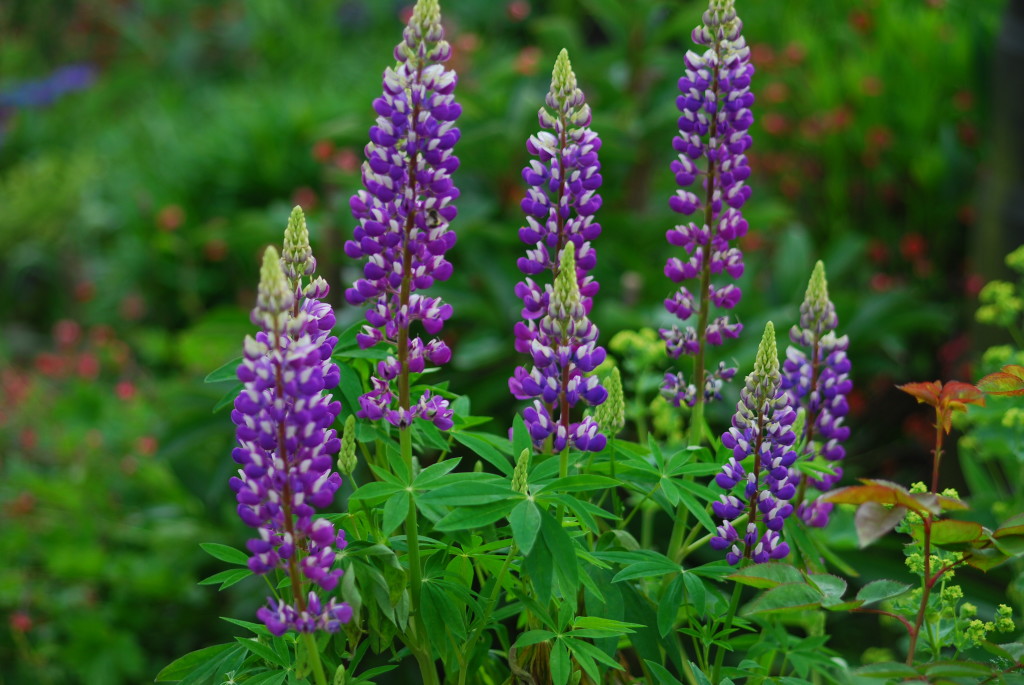
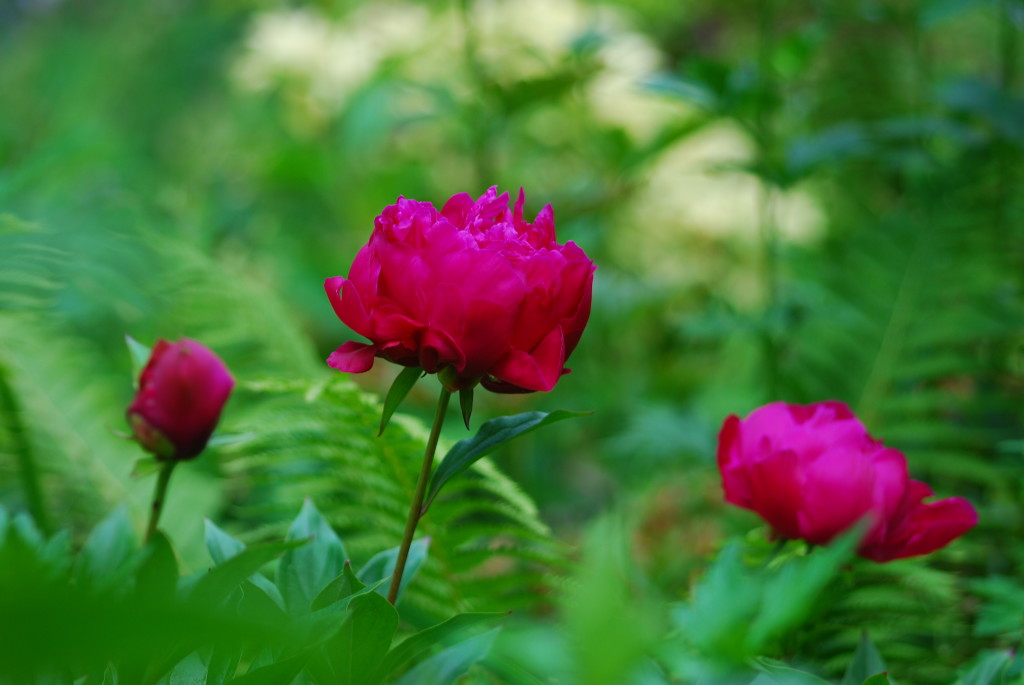
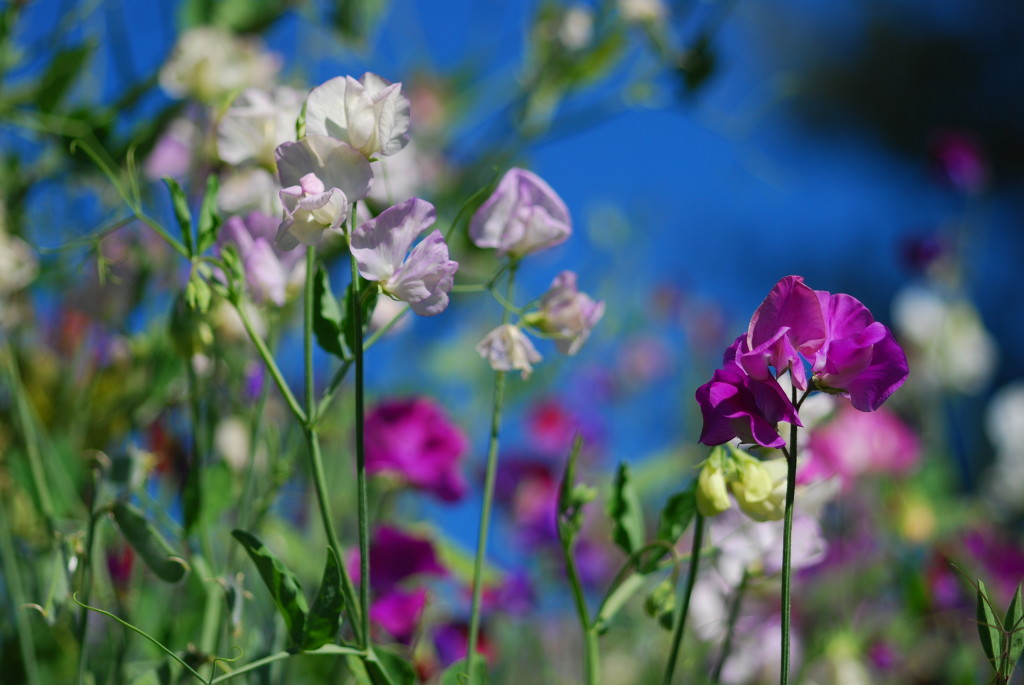
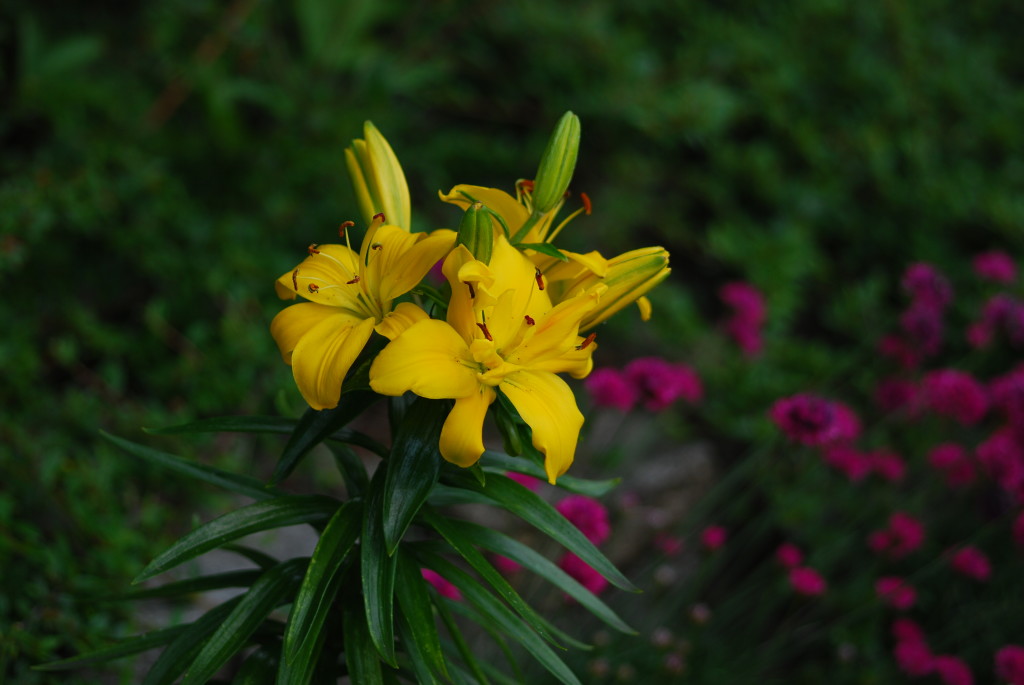
Copyright Valerie J. Hayes and Quiet West Vintage (2015). Unauthorised use and/or duplication of this material without express and written permission from this blog’s author/owner is strictly prohibited. Excerpts and links may be used, provided that full and clear credit is given to Valerie J. Hayes and Quiet West Vintage with appropriate and specific direction to the original content.
August 23, 2014
| Valerie Hayes
| Business & Web Development, Feature Articles, Inside Passage Legendary Map, My Story, Poetry By Valerie Hayes, Thoughts & Ideas, View All Articles & Photos, Vintage Hats

Inside Passage Legendary Map By Quiet West Publishing
Ladies Wear Many Hats
Ladies wear many hats ~
We put the lady on the map,
To illuminate despair –
To journey where we dare;
To follow rivers to wilderness,
To fly and then return to nest.
To soften contours of the stone –
And pave the road with poems.
Valerie J. Hayes
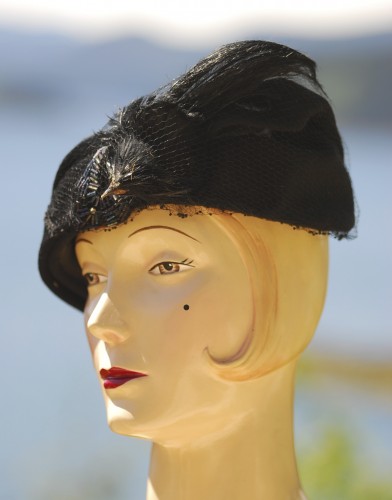
Early 1900’s with Real Bird. This Practice was Banned in 1909
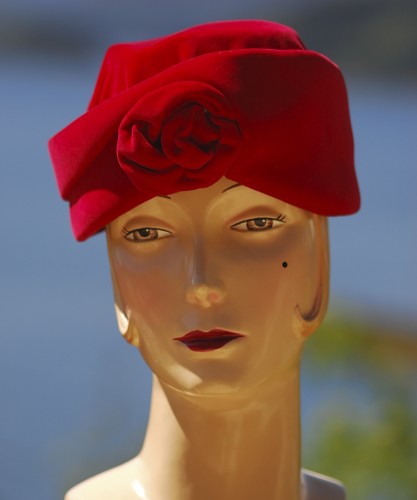
1960’s Velvet Rose Hat
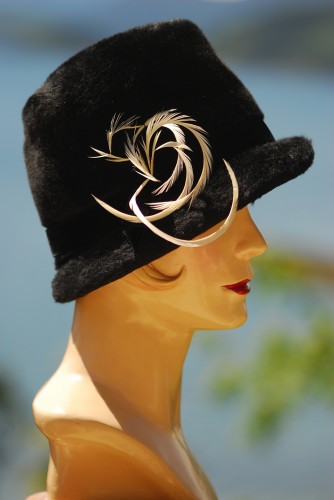
1940’s White on Black
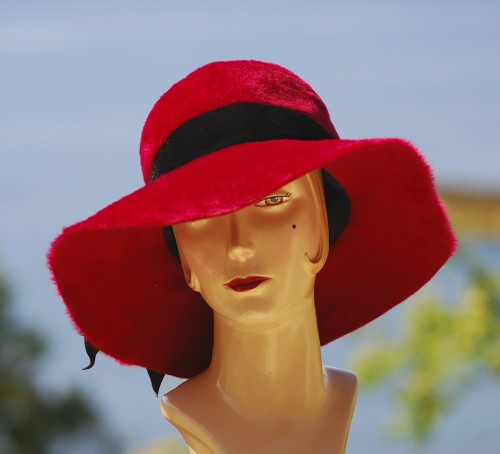
1950’s Scarlet Glamour
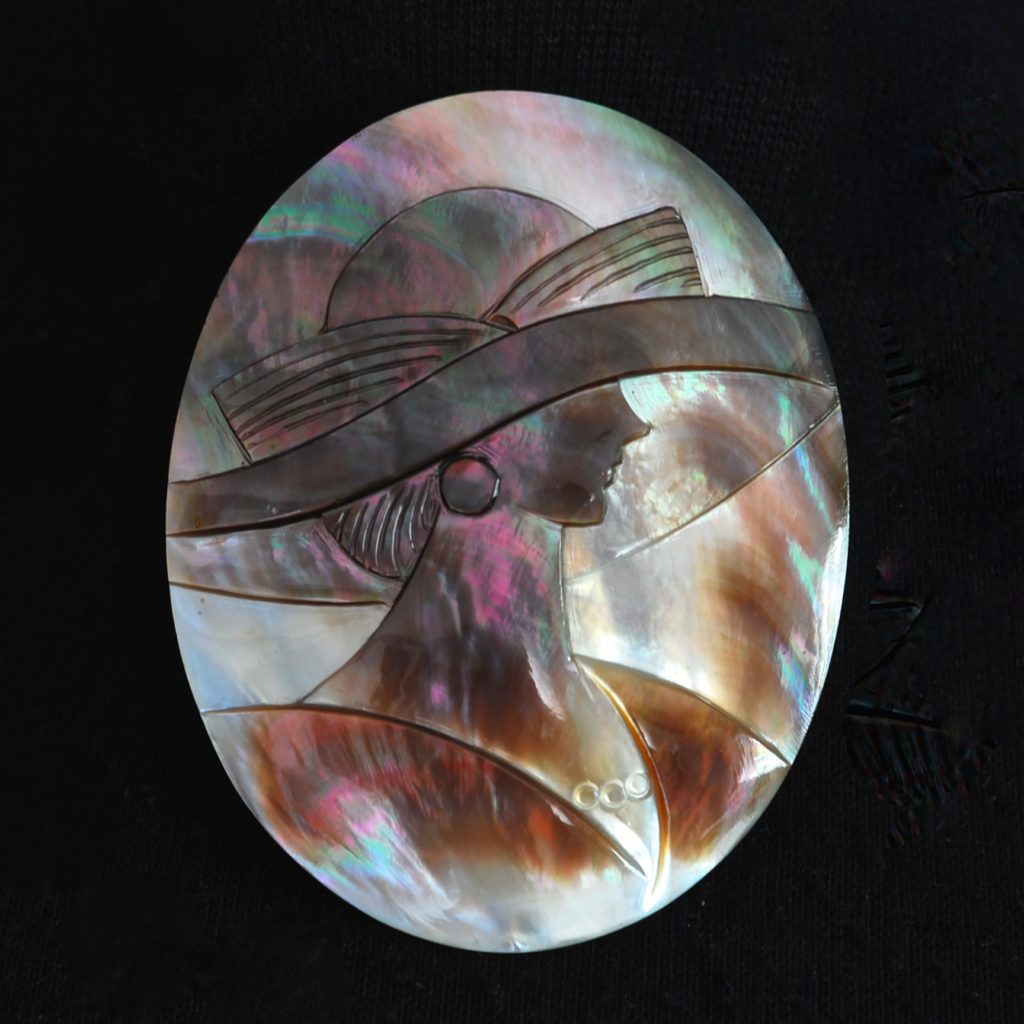
Carved Mother Of Pearl In Natural Sun Lit Colours
Copyright Valerie J. Hayes and Quiet West Vintage (2014). Unauthorised use and/or duplication of this material without express and written permission from this blog’s author/owner is strictly prohibited. Excerpts and links may be used, provided that full and clear credit is given to Valerie J. Hayes and Quiet West Vintage with appropriate and specific direction to the original content.










